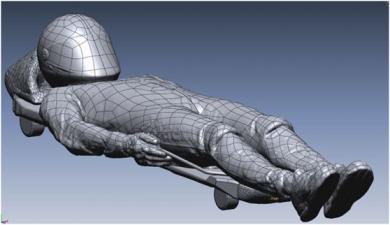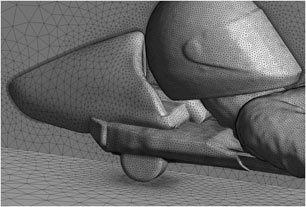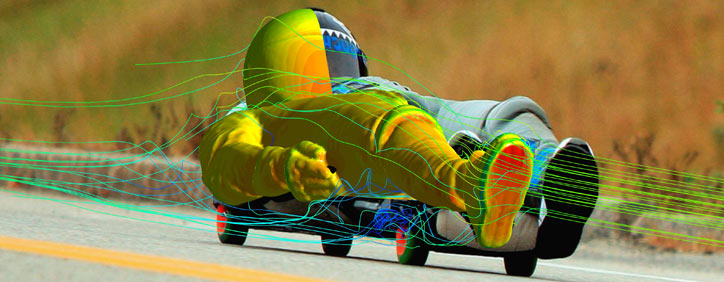CFD pushes back the speed limits in street luge
Holders of the Guinness speed record in street luge (157 km/h), luge enthusiasts from Québec City decided to take up a new challenge: pass the symbolical mark of 100 mph, with no engine! Among these thrill seekers was Louis-Étienne Bouchard, account manager at Creaform.
“Our luge team, the 3 Bobs, broke the world speed record in September of 2008, and we came very close to the 100 mph at that time, he said. Since then, we have tweaked our gear, but we had a hard time figuring out how to improve the aerodynamics of our luges to gain even more speed.”
Louis-Étienne and his teammates asked Creaform’s digital simulation team to help them out. The goal: using CFD to simulate air flows in order to reduce the aerodynamic drag and break their very own speed record!
Step 1: 3D scanning
To digitally simulate flows, you first need a computer model of the object. In this case, a representation of the surfaces in contact with air was the only thing required, and it was essential to get the exact 3D reconstruction of the luge racer in sliding position. This was done quite easily with a Handyscan 3D handheld portable scanner, developed by Creaform, and the surface mesh generated has been transferred to the digital simulation team.
 Step 2: Fluid mesh
Step 2: Fluid mesh
The surface mesh is used as a starting point to define the air volume around the object to be analyzed, and it is later divided into several small elements: this is the fluid mesh. In this case, the file was made of 3 million elements. Using physics laws called the Navier-Stokes equations, the flow characteristics such as speed, pressure, temperature and turbulence level have been calculated for each of these elements.
 Step 3: Analysis and recommendations
Step 3: Analysis and recommendations
This provides info on the flow behaviour on any point of the calculation volume, which makes it possible to calculate with precision the aerodynamic shapes on the body, as well as the air particles.
“By calculating the CFD from the real scanned geometry, we were able to identify several ways to increase the top speed, explained Creaform fluid dynamics specialist Steve Julien. We found that with a new profile on the rear of the luge and by modifying the position of the luge racer, it was possible to limit the zones of high pressure while reducing the flow recirculation zones. We also found out that the suit created a lot of rugosity on the lower body and that it actually increased unnecessary chafing. Thanks to the modifications that we have made, we were able to easily gain between 5 to 10 km/h. The high accuracy scanning file generated with the Handyscan 3D portable scanner turned out very helpful, as it provided us with a wealth of information that we would not have had otherwise.”
Step 4: Let’s break that record!
On June 18, 2012, current Guinness record holder Cédric Touchette is lying on his new and more aerodynamical luge, ready to rush down the famous Éboulements hill, located in the Charlevoix area in the province of Quebec, Canada. During a practice race preceding the race officially monitored by the Guinness records organization, mechanical issues arise: “The wheels started to vibrate and my luge to wobble. I got pulled off to the left and I saw the concrete wall coming in on me. When you’re rolling that fast, it is really scary! I’m done chasing records for now!” But it is worth mentioning that during that “slow” practice race, our thrill seeker still peaked at 152 km/h!
“I remain convinced that the new luge could break the record, Steve insisted, but I’m not reckless enough to throw myself down that hill to prove it!”
CFD in a nutshell
A true virtual laboratory, computational fluid dynamics makes it possible to analyze, design and optimize any system involving a liquid or a gas. You can:
- Detect an issue before it arises or correct and existing problem;
- Get a better physical understanding of the system;
- Test the operating conditions and validate new concepts.
This powerful engineering tool helps in reducing costs and development cycles while improving the quality and reliability of the products. Through its 3D Engineering Services, Creaform offers a wide array of digital modeling approaches. Our skilled engineers will help your company find the most efficient and reliable solution to structural, dynamic, thermal or fluid dynamics issues.


 Step 2: Fluid mesh
Step 2: Fluid mesh Step 3: Analysis and recommendations
Step 3: Analysis and recommendations



